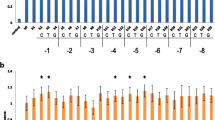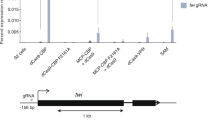Abstract
Cyp1p (Hap1p) activates, among others, the two structural genes, CYC1 and CYP3 (CYC7) which encode isocytochromes c in Saccharomyces cerevisiae. This activation is believed to occur through the binding of the protein to the dissimilar upstream activation sequences (UASs), UAS1 and UAS′, present upstream of CYC1 and CYP3, respectively. In this paper, we describe a novel promoter mutation, CYP3-5, which results from a 39-bp deletion located about 160 bp upstream of the well-characterized CYP3 UAS. This deletion includes a sequence identical to the 3′ moiety of the CYC1 UAS1. Strikingly, a sequence identical to the 5′ part of the CYC1 UAS1 is also present 60 bp downstream of the 3′ half in the wild-type gene, suggesting that a spatial organization of the promoter might lead to the reconstitution in vivo of an active UAS1-like sequence. Interestingly, we find that in the presence of the CYP3-5 mutation, which disrupts this potential UAS1, the CYP1-UAS′ complex is importantly diminished and the transcription of CYP3 is insensitive to the wild-type CYP1-activating protein.
Similar content being viewed by others
Author information
Authors and Affiliations
Additional information
Received: 9 June 1996/Accepted: 1 July 1996
Rights and permissions
About this article
Cite this article
Lodi, T., Petrochilo, E., Gaisne, M. et al. Characterization of a promoter mutation in the CYP3gene of Saccharomyces cerevisiae which cancels regulation by Cyp1p (Hap1p) without affecting its binding site. Mol Gen Genet 253, 103–110 (1996). https://doi.org/10.1007/s004380050302
Issue Date:
DOI: https://doi.org/10.1007/s004380050302




